Abstract
The underground distribution network is an essential part of our domestic and commercial area buildings. PVC cables are mostly used for household wiring, including underground cables installation in LV distribution networks. Small cracks in cable insulation or gaps in connectors during or after installation can cause water to seep through onto the conductor. Heated conductors in the presence of water causes corrosion of the conductor and eventual failure. These are the most common causes of emerging faults in underground networks. Such faults occur frequently and result into a permanent failure soon after the occurrence. Failures mostly arise in low voltage levels in distribution systems and have a large impact on their durability. In addition to the fact that the majority of customers are affected, the impact to annual customer minutes lost is significant and the annual expenses of resolving the outages can become large. Al/PVC/PVC cables are mostly used for commercial installation, including four different sizes: 10 mm2 (2-core, 4-core), 120 mm2 (4-core) and 240 mm2 (4-core). In this research, the effect of corrosion on these sizes was studied under electric stress. Deterioration of an Aluminum conductor was used to investigate the effects of heat and voltage. Such parameters highly influence the rate of corrosion.
1. Introduction
Underground cables are used in distribution networks, mostly in urban areas where overhead lines are prohibited, such as in territories where state and local guidelines take precedence over economic aspects, near airports, as well as some other zones where overhead networks could endanger the public, and in scenic spots where aesthetics are a priority [1]. Commercial buildings have distinct regulations and also different requirements when regarding electrical installations compared with households and industrial buildings. For example, office hardware and devices might necessitate different networking and cable management than industrial equipment or facilities [2]. In the case of commercial networking, there are indeed a number of factors to consider in relation to energy requirements and usage. Among the most crucial factors to take into account is safety, as any flaws in the power lines might endanger personnel and cause the enterprise to shut down [3].
Burying cables deep in the ground can prevent the risk of physical contact and electrical shocks or sparks. Underground cables seem to be more robust because they are not subjected to the same atmospheric and mechanical forces as above-ground cables [4]. Such cables are ideal for delivering power to skyscrapers, hotels, institutions, companies, and government agencies. These cables are often utilized in advanced economies for extensive transmission and distribution networks; however, they are generally not approved for the use over LV distribution due to economical and protection issues [5]. The underground distribution network has gained much attention, particularly in crowded areas, to avoid any disruptions caused by natural disasters (e.g., lightning, tornadoes, heavy storms, etc.) [6].
A common cable size used in the domestic distribution systems is 10 mm2 (2-core, 4-core). These cables have different protection layers for the conductor, including PVC (for sheath and armoring). Although this type of cable has higher durability, shielding, elastic modulus, and optimum electrical conductivity. Also its infrastructure cost will be higher compared to an overhead structure and its maintenance and operation expenditures are not cost-effective [7]. In household networks, single-phase or three-phase connections are used. The increasing population has a crucial effect on the load profile of the system [8].
Cable insulation has a certain set of benefits and limitations and no single insulation material exhibits all of the desirable characteristics [9]. The choice of cable is solely determined by the environment where it would be placed, taking into account each of the afore mentioned parameters, as well as the cost and electric stress level. However, due to the contaminants present in the environment of highly alkaline soil under the earth, the installed cables’ sheath is easily targeted by chemical substances, such as salts, acids, alkaline earth metals, and so on, at high temperatures, as well as pressure, causing both the sheath and core shielding to deteriorate [10]. This loss of insulation material results in leakage current, causing electrical discharges, which eventually lead to conductor damage [11]. The erosion of plasticizers and oxidation are some of the processes that can occur in the thermal decomposition of PVC and which significantly contribute to current leakage among cores and ultimate failure [12].
For electric lines, copper and Aluminum are common conducting elements. Around the world, Aluminum is the most commonly used material in the LV network. It is recommended due to its minimal price while still providing adequate electrical conductivity. Aluminum, on average, can tolerate corrosion in a wet atmosphere [13]. Once a layer of Aluminum oxide is applied to a metal surface, the corrosion rate comes to an end. However, eddy currents, whether DC or AC, are believed to trigger Aluminum corrosion. A specific current flow is required for corrosion; however, the mechanism is not well recognized [14]. This research explores the impact of several extremely critical criteria for AC-triggered corrosion in perspective of Aluminum as a conductive material in LV underground power lines. For water sunk conductors, the aqueous environment functions as an electrolyte and the findings will be used in statistics evaluation and risk assessment studies [15].
2. Methodology
The main concern of this study was the electro-chemical analysis of the corrosion of various PVC cables. The aging of four separate Aluminum cable specimens was carried out in the laboratory and overall deterioration after each phase was evaluated by comparing fresh samples and properties previously published in the literature. Cable sizes including 10 mm2 (2-core, 4-core), 120 mm2 (4-core), 240 mm2 (4-core) with similar lengths (represented in Figure 1) were selected as test specimens. Different chemicals including (NACL, acid, alkaline solutions) were applied as chemical stress and small punches on sheath were made to stress the cable mechanically. Research was carried out on 1000 h of aging in the multiple stress environment to check the water penetration in the cable. Continuous electric stress was applied in this entire 1000 h of aging cycle. Changes in the current and voltage parameters were organized with different techniques for each cycle to obtain the final results. This study examines the impact of two extremely significant aspects for AC-triggered corrosion in the perspective of Aluminum as a conductive material for LV subterranean power lines. The conductivity of water, which serves as an electrolytic solution, and its temperature are the characteristics for immersed conductors. The findings will be used in research evaluation and risk assessment studies.
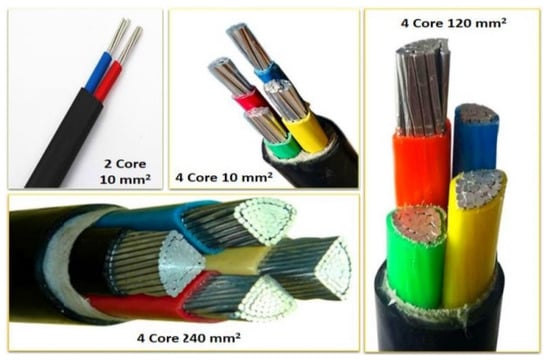
Figure 1.
Aluminum Cable Sample Sizes.
3. Experimental Setup
The test setup for the experiment was created in a controlled aqueous environment to attain the realistic conditions for underground LV cables in order to study the corrosion effect on Aluminum conductor under the impact of AC. Figure 2 represents the schematics of the test setup. Cable specimens after artificial puncture at certain points were placed in the immersed condition. Temperature of the water was maintained at 20 °C with the minimum margin of 0.5 °C with the help of a thermostat attached with the cooling circuit.
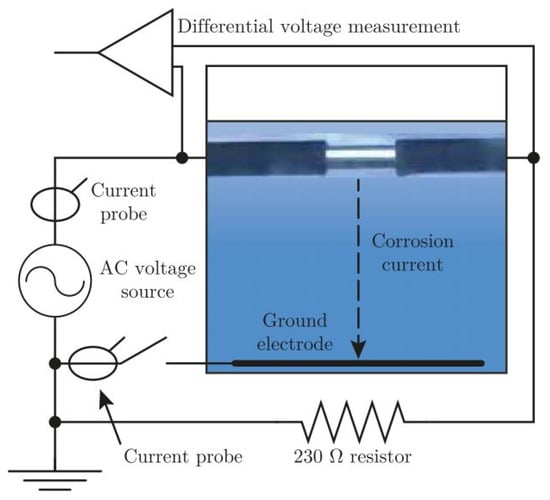
Figure 2.
Schematics of the Test Setup.
For the experiment, 99% of pure Aluminum cable samples were used. This class of Al cables is usually used for installation in power networks. Samples were cut into a length of 45 cm and interruption was created at the center on specimens through insulation puncture. A copper plate was placed as ground at the bottom of container. The whole experiment was performed at a temperature of 20 °C considering it in the range of earth temperature for underground cables. Tap water was used as electrolytes (having conductivity 0.35 mS/cm) in the experiment. Adding the NACL increased the conductivity with 0.01 mS/cm value.
In the entire experiment, voltage level was at 240 V (50 Hz), applied at the far ends of electrodes. This voltage level constitutes phase to neutral voltage level in the domestic power network. A circuit breaker was used to interrupt the corrosion current path, allowing the resistivity of the Aluminum electrode to be estimated using the differential voltage measurement and also the measurement of current provided by the source. When the specimen under the experiment breaks apart, the experiment is over. A rapid, substantial voltage rise at the differential voltage amplifier’s source can be easily identified in this exact moment. Figure 3 represents the final aged samples when the Aluminum conductor finally breaks apart.
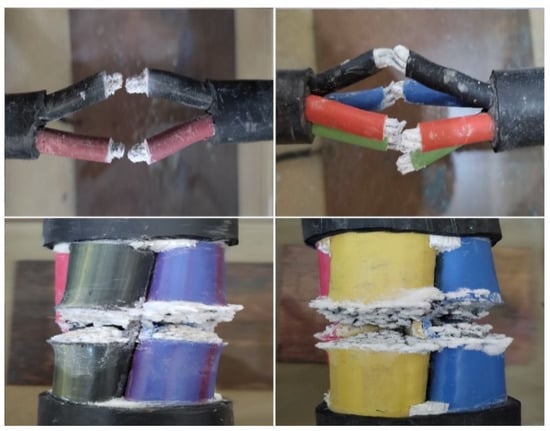
Figure 3.
Aged Samples after 1000 h.
4. Results and Discussion
The timeframe of the experiment is the duration in between the application of electric stress and the eventual failure of the Aluminum cable conductor. The change in the conductivity with respect to time was observed and is presented in Figure 4. The plot shows the linear dependency besides the low conductivity value at 20 °C.

Figure 4.
Overview of duration of experiment.
A visual inspection of the samples throughout the experiment at high conductivity value found that the corrosion byproduct was formed and rapidly separated from the surface of the conductor. This effect may describe the experiment’s exceedingly long period at 20 °C and conductivity at 0.35 mS/cm. The electrolytic solution’s conductivity was minimally altered by the operation. According to Equation (1), a linear relation may be inserted in the above plot at an applied temperature value in Figure 5.
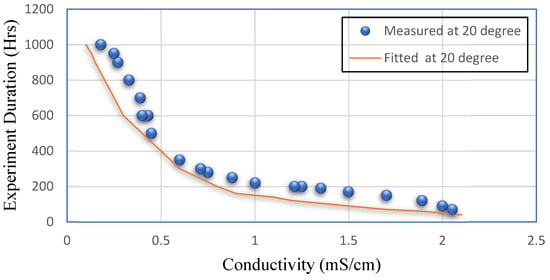
Figure 5.
Overview of duration of experiment with the fitted values.
In the above equation, represents the experiment duration, shows the electrolyte conductivity at the start, is the tap water conductivity, whereas and depend on the temperature values given in Table 1.

Table 1.
Fitting Parameters.
Whenever a malfunction in the secondary distribution system triggers the breaker, the outage is defined as an intermittent fault, although the circuit appears to work properly after the breaker is replaced. Unfortunately, the issue will usually resurface after a certain time, ranging from a few minutes to several weeks, or even more. Such intermittent failures are believed to be the result of earlier damage caused by the wire conductor and insulations interacting with the moist atmosphere. Dry-band arcing is caused by an electrolyte that partially evaporates, producing a narrow spectrum with a strong electric field intensity. Arcing generates black spots on the insulating material and in between the conductors, causing it to melt and polluting the area with conductive powder. A breakdown happens when enough impurity has accumulated on the insulator’s top. The currents participating in the dry-band arcing mechanism are likely to be difficult to differentiate from the load currents, particularly in the case of LV cables. The breakdown of conductor results in hundreds of amperes or more, which may be clearly monitored in the secondary distribution system. Current peaks and voltage waveform in such breakdowns were observed and are shown in Figure 6 and Figure 7.
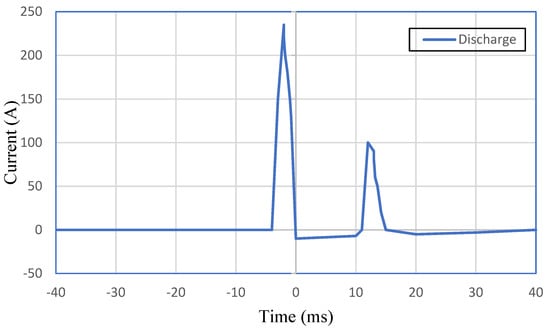
Figure 6.
Discharge Current.
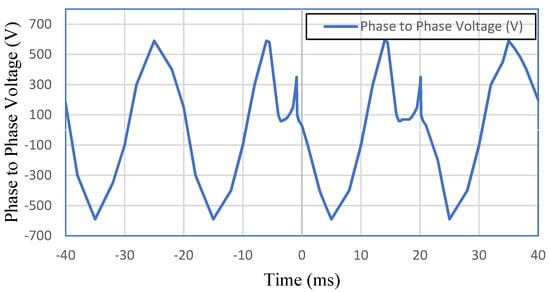
Figure 7.
Phase to Phase voltage during breakdown.
The current peak values are shown in the plots, and they could reach levels that are outside the measuring range of the equipment. Only twice did it result in a tripped breaker. Because all the phases of a broken cable portion had been bound with each other in these occurrences, a restoration action can be initiated. It has been determined that for upcoming developments, unless it is absolutely necessary, no repairs will be made excluding the replacement of the breaker. In this method, a more accurate estimate of a fault’s progression can be achieved.
5. Conclusions
The corrosion effect on an underground Aluminum cable in an LV distribution network was investigated. Electric stress of 240 V was applied across the far ends of the samples and a ground path was given through electrolytic solution of brine in a temperature-controlled environment. It was observed that the induced corrosion of Aluminum was slightly dependent on the temperature range around 20 °C. A higher temperature resulted in accelerated corrosion. Intermittent current peaks were observed and recorded with the equipment. From the resulting current peaks, the future failure of cables can be predicted. However, the small current peaks could not be recorded, but the next generation system in the future may deal with it to minimize the number of outages in the system.
Author Contributions
Conception, methodology formation, conducting tests and results collection, analyzing and presenting the results: M.B.Z.R., S.A., Y.B., M.S. All authors have read and agreed to the published version of the manuscript.
Funding
This research received no external funding.
Institutional Review Board Statement
Not applicable.
Informed Consent Statement
Not applicable.
Data Availability Statement
Not applicable.
Conflicts of Interest
The authors declare no conflict of interest.
References
- Mueller, C.E.; Keil, S.I.; Bauer, C. Underground cables vs. overhead lines: Quasi-experimental evidence for the effects on public risk expectations, attitudes, and protest behavior. Energy Policy 2019, 125, 456–466. [Google Scholar] [CrossRef]
- Zheng, Y.; Yi, T.; Zhang, G.; Zhang, Y.; Yang, F.; Song, W. Optimization design for rating calculations of power cables in pipes. In Proceedings of the International Symposium on Electrical Insulating Materials, Kyoto, Japan, 6–10 September 2011; pp. 417–420. [Google Scholar]
- Al-Khalidi, H.; Kalam, A. The impact of underground cables on power transmission and distribution networks. In Proceedings of the First International Power and Energy Conference, (PECon 2006) Proceedings, Putra Jaya, Malaysia, 28–29 November 2006; pp. 576–580. [Google Scholar]
- Cole, S.; van Hertem, D.; Meeus, L.; Belmans, R. Technical developments for the future transmission grid. In Proceedings of the International Conference on Future Power Systems, Amsterdam, The Netherlands, 18 November 2005. [Google Scholar]
- Linde, E.; Gedde, U.W. Plasticizer migration from PVC cable insulation—The challenges of extrapolation methods. Polym. Degrad. Stab. 2014, 101, 24–31. [Google Scholar] [CrossRef]
- Mead, J.L.; Tao, Z.; Liu, H.S. Insulation materials for wire and cable applications. Rubber Chem. Technol. 2022, 75, 701–712. [Google Scholar] [CrossRef]
- Matheson, A.F.; Charge, R.; Corneliussen, T. Properties of PVC compounds with improved fire performance for electrical cables. Fire Saf. J. 1992, 19, 55–72. [Google Scholar] [CrossRef]
- De Clerck, Q.; Van Slycken, J.; Van Den Berg, M.; Colin, P.; Meunier, J.M. Parameters of influence on low-voltage cable ageing. CIRED-Open Access Proc. J. 2017, 2017, 380–383. [Google Scholar] [CrossRef]
- Starnes, W.H. Structural and mechanistic aspects of the thermal degradation of poly(vinyl chloride). Prog. Polym. Sci. 2002, 27, 2133–2170. [Google Scholar] [CrossRef]
- Otake, Y.; Kobayashi, T.; Asabe, H.; Murakami, N.; Ono, K. Biodegradation of low-density polyethylene, polystyrene, polyvinyl chloride, and urea formaldehyde resin buried under soil for over 32 years. J. Appl. Polym. Sci. 1995, 56, 1789–1796. [Google Scholar] [CrossRef]
- Esmail, A.H. Impact of Insulation and Sheathing PVC Mixture on the Physical Properties. Sch. Int. J. Chem. Mater. Sci. 2020, 3, 24–30. [Google Scholar] [CrossRef]
- Tawancy, H.M.; Hassan, M. On the Degradation Mechanism of Low-Voltage Underground Cable with Poly(Vinyl Chloride) Insulation. J. Mater. Eng. Perform. 2016, 25, 2288–2295. [Google Scholar] [CrossRef]
- Packa, J.; Váry, M.; Lelák, J.; Šály, V. Degradation of 230/400 V distribution cables with PVC insulation. In Proceedings of the 18th International Scientific Conference on Electric Power Engineering (EPE), Kouty nad Desnou, Czech Republic, 17–19 May 2017. [Google Scholar]
- Rowland, S.M.; Wang, M. Fault Development in Wet, Low Voltage, Oil-Impregnated Paper Insulated Cables. IEEE Trans. Dielectr. Electr. Insul. 2008, 15, 484–491. [Google Scholar] [CrossRef]
- Kemari, Y.; Mekhaldi, A.; Teguar, M. Investigation into the dissipated energy under accelerated thermal aging in PVC/B used in low-voltage cables insulation. In Proceedings of the 2016 IEEE International Conference on Dielectrics (ICD), Montpellier, France, 3–7 July 2016. [Google Scholar]
Publisher’s Note: MDPI stays neutral with regard to jurisdictional claims in published maps and institutional affiliations. |
© 2022 by the authors. Licensee MDPI, Basel, Switzerland. This article is an open access article distributed under the terms and conditions of the Creative Commons Attribution (CC BY) license (https://creativecommons.org/licenses/by/4.0/).